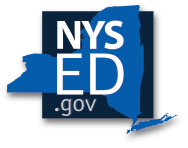Program Content
|
CR 100.5(6)(iv)(a)(2)(i) a technical and academic curriculum that achieves the commencement level of the appropriate New York State learning standards for all courses in the career and technical education program, including integrated and/or specialized English, mathematics, science, economics and government, and faculty with State certification in appropriate academic and/or technical subjects; |
|
Definitions:
|
Content Requirements for a Secondary NYSED-Approved CTE Program
- Program content must include a minimum of 3.5 units of credit of CTE coursework, inclusive of a ½ unit of credit of Career and Financial Management, that aligns with the federal definition of a program of study.
- The program must align to the New York State CDOS standards, appropriate New York State Standards, and industry standards.
Some program areas may have additional content-specific considerations that have not been addressed in this resource. For example, health sciences programs must provide a minimum of 4 units of credit; 2 units of health sciences core, 1 unit of content-specific theory, and 1 unit of supervised clinical in the work-related healthcare setting. For further information about content-specific requirements, please visit the appropriate CTE content area page or contact the appropriate content area associate.
Federal Definition of a Program of Study
Perkins V defines the elements necessary to form a program of study. This definition, combined with New York State’s regulations, inform the policies and procedures guiding program approval. While not all schools may directly receive Perkins funds, the federal definition is applied to all NYSED-approved CTE programs. This definition requires that all programs:
- Incorporate challenging state academic standards
- Address both academic and technical knowledge and skills, including employability skills which are delivered through New York’s Career and Financial Management (CFM) framework
- Align with needs of industries in the economy of the state, region, tribal community, or local area
- Progress in specificity (beginning with all aspects of an industry or career cluster and leading to more occupation-specific instruction)
- Culminate in the opportunity for students to attain a recognized postsecondary credential including opportunities for college credit, advanced standing, industry certifications, licensure, and collegiate degrees in the career area)
- Provide multiple entry and exit points along the career and technical education continuum
Standards for Curriculum Alignment
Submission of standard crosswalks is not a routine requirement for program approval; however, applicants should be prepared to submit crosswalks if requested as part of the program review.
Career and Financial Management
Career and Financial Management (CFM) provides students with the necessary career and life skills for success beyond high school.
Career and Financial Management:
- Must be included in all secondary NYSED-approved CTE programs.
- Must include the sixteen themes identified in the Career and Financial Management framework.
- Can be delivered as either a stand-alone course or can be embedded throughout the content of a CTE program. The method in which CFM curriculum is delivered is local discretion.
- If CFM is delivered as a stand-alone course, it must be a minimum of ½ unit of credit (equivalent to 1 NYC credit) and reported using SCED code 72211.
- If CFM is delivered as embedded content, then CFM would not be identified and reported as a separate course, the time spent on CFM content would be included throughout the program. A crosswalk demonstrating where the sixteen themes are addressed in the program of study should be completed. Applicants should be prepared to submit a CFM crosswalk if requested as part of the program review.
- Regardless of how CFM is delivered, the program must provide a minimum of 3.5 CTE credits. Below is an example of how this may look in the program application.
| CFM delivered as a stand-alone course | CFM delivered as embedded content |
|
Agriculture Program
Total 3.5 credits |
Agriculture Program
Total 3.5 credits |
Integrated and Specialized Academics
Integrated and specialized academics in a secondary NYSED-approved CTE program is optional. If incorporating integrated or specialized academics, the appropriate New York State academic standards must be used. Please see integrated and specialized academics webpage for more information.
Templates
These templates are intended to serve as a guide/example and may be used at the district’s discretion. Districts are not required to use these templates and are welcome to develop their own instruments that align with the components and practices outlined above.





